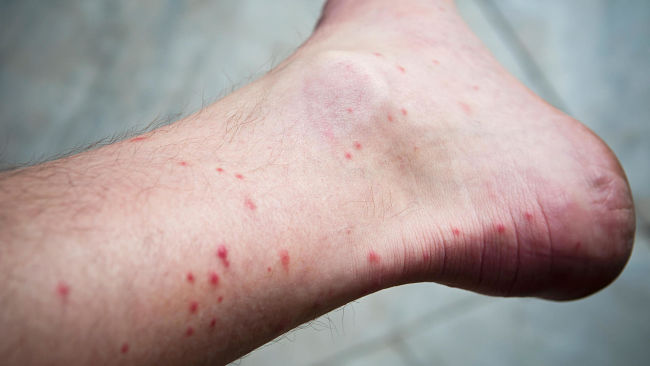Home treatments for flea bites

Numerous mosquito bites on a man’s lower leg and ankle
Flea bites are very uncomfortable and most children are plagued with them. Fleas are often brought in from kindergartens or even school, but the main sources are animals, such as dogs or cats.

Fleas are small insects that feed on the blood of animals, especially cats, dogs and humans that are in contact with these animals and that are contaminated.
Table of Contents
Symptoms of flea bites
The way in which a flea bite appears on the skin is by appearing a small red circle with a point in the center, feeling itchy and forming a small inflammation in the area.
These bites are usually at the level of the legs and ankles, and are commonly related to a living organism. Certain people may have more swelling and others less, depending on the level of allergy they have to the same flea itch.
How do you recognize a flea bite?
There are several symptoms that can help you recognize a flea bite:
Bites in a row: fleas use orientation points to guide themselves. As a result, there are often a number of flea bites, not just one.
Itching: flea bites cause a pronounced itch, so it often happens that at night children scratch their bites and they can become infected.
Reddish spot: Flea bite often leads to swelling of the skin, making the bite recognizable as a reddish spot.
Treatment for flea bites
Two things are essential against flea bites: keep the area clean and avoid scratching (this is often difficult to achieve when the itch is intense).
To treat bites the area should be kept clean and scratching should be avoided. So, you should apply an antiseptic on the area, or simply wash with cold water and soap. This to avoid secondary infections.
Medical treatments
- If the bite is pronounced itching and swelling, creams such as Hydrocortisone, an over-the-counter medicine, can be applied.
- Another option is refreshing ointments or creams with antihistamines or corticosteroids, with them an effect is achieved that helps to reduce inflammation of the area and relieve itching.
In severe cases, when the bites are inflamed and they have been rubbed or scratched, infection can be one of its consequences, in those cases antibiotics are recommended, but these treatments must be evaluated by the doctor.
Home remedies
There are several home remedies to relieve the itchiness caused by flea bites that you can use without leaving your home.
1. Baking soda
Mix baking soda with a few drops of water to form a paste and apply to the sting area. Then, leave it on the skin for 15 -30 minutes which will calm the annoying itching sensation.
Another is to boil a lemon peel in 250 cc. of water. Let the liquid rest and then apply with a cotton ball or gauze on the affected area.
2. Apple cider vinegar
Mix two tablespoons of water and one tablespoon of organic apple cider vinegar. Then, keep in the fridge for a few hours and apply in the same way on the bite.
3. Parsley
Parsley, also crushed, can be used as a compress for at least 30 minutes or overnight.
4. Honey
Honey has an antibiotic effect and can also be applied to the skin immediately after the sting. This reduces swelling and prevents inflammation, thus avoiding infections as it will not cause as much need to scratch.
5. Basil
Basil puree and sage leaves have anti-inflammatory effects. The substances of these medicinal plants very quickly penetrate into the affected area, so that it is enough only to rub the site of the bite.
6. Onion
The onion has been known for its antibiotic effects. Use the onions as an overnight compress for an anti-inflammatory benefit that will relieve itching.
There are various products to combat them, and the veterinarian can advise what is the best treatment to eliminate fleas from your pet.
If the discomfort persists or worsens, consult a doctor.

